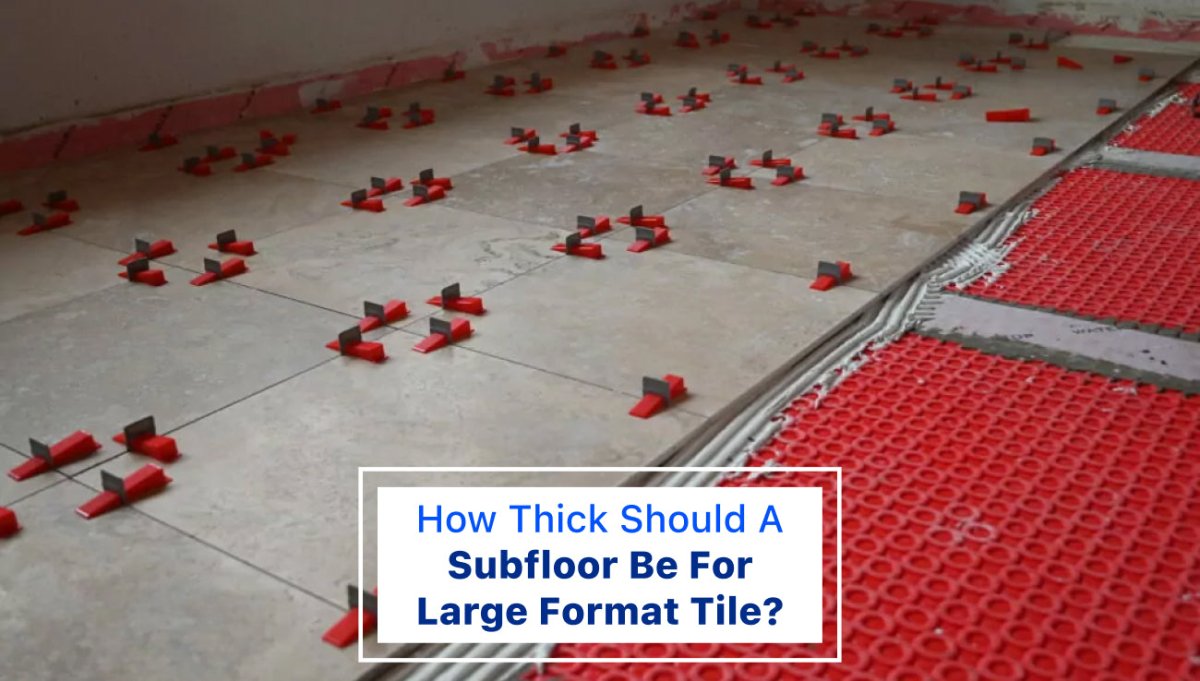Famed as the hallmark of the modern design, the Large Format Tile offers an expansive and flawless surface. The surface of these tiles exudes style and smoothness. If you’re trying to renovate a residential or commercial space, you need to understand the role subfloor thickness plays in maintaining these tiles.
Why Subfloor Thickness Matters
If you don’t know, the subfloor is the main foundation for your entire flooring system. It provides support and stability, which impacts the overall performance of your large format tiles.
The large format tile, like large format porcelain tile are more prone to cracking and breaking only if the subfloor is not properly prepared. That’s why it is reasonable to determine the appropriate subfloor thickness.
Factors Influencing Subfloor Thickness
Several factors influence the required thickness of the subfloor for large format tile installations:
- Tile Size and Weight: Large format tile sizes vary but typically refer to tiles that exceed traditional dimensions, often starting from 15 inches on one side. These tiles are heavier and require a stable base to support their weight without flexing or cracking.
- Subfloor Material: One factor that influences subfloor thickness is the material. Plywood, oriented strand board (OSB), or concrete are some of the subfloor materials. These materials impact their structural integrity and ability to withstand the weight and movement of large format tile.
- Span and Joist Spacing: In residential and commercial settings, the spacing between floor joists and their span plays a significant role in determining subfloor thickness. Greater spans and wider joist spacing may necessitate thicker subflooring to maintain stability.
Recommended Subfloor Thickness for Large Format Tile

According to industry and expert standards, the minimum subfloor thickness for large-format tiles is generally 1 1/4 inches for plywood or OSB subfloors.
Now you must be wondering why. Why this thickness? Well, this thickness provides sufficient support and also minimizes the risk of cracks or damage to the tiles.
If we talk about in commercial settings where the large format tile are installed for their style and durability, we have to make sure that we choose a strong subfloor. Commercial spaces are sworn to experience heavier foot traffic than usual, and of course heavier foot traffic means more mechanical stress. In that case you should look out for the thickness and strength of the subfloor.
Key Considerations for Commercial Installations
Because of their smooth and sleek design, these tiles are popular in commercial spaces. These large format tiles are also easy to maintain. Want to install the Large Format tile in your commercial space? Installing them requires meticulous planning and adherence to the recommended guidelines:
- Traffic Load: You need to ensure what kind of traffic and what kind of volume the space will endure daily. Talking about areas that receive heavy traffic, such as malls or airports, require more thicker subflooring to prevent premature wear and to maintain structural integrity.
- Moisture and Climate: The temperature and moisture content of commercial spaces may fluctuate. The proper thickness of the subfloor aids in reducing the effects of these environmental factors' expansion and contraction.
Ensuring Successful Installations
If you want to achieve a successful large format tile installation, you should follow a detailed approach that includes the following:
- Professional Assessment: Before installing tiles, you need to consult with a qualified contractor or a tile installer who can assess the requirements for your project and recommend the right subfloor thickness for you. It’ll all be based on where your space is.
- Quality Materials: Always use high-quality subfloor materials suitable for the type of large format tile you consider installing. What does it do? This guarantees the compatibility improves the overall performance and durability of the flooring system.
- Adherence to Guidelines: Follow manufacturer guidelines and industry best practices strictly throughout the installation process. This includes proper subfloor preparation, adequate curing times, and using compatible adhesives and grouts.
Conclusion
In conclusion, the thickness of the subfloor plays a pivotal role in the successful installation of large format tile, whether in residential or commercial settings. By understanding the unique demands of large format tiles and implementing appropriate subfloor thickness, you can achieve a flawless and long-lasting flooring solution that enhances the aesthetic and functionality of any space.
For more insights on subfloor preparation and large-format tile installation, visit BuildMyPlace, your one-stop home improvement store in Louisville, Kentucky. We also offer a video call chat feature, through which you can interact with our in-store experts and get live guidance for your next home project.
FREQUENTLY ASKED QUESTIONS
Q. What is considered a large format tile?A. Large format tiles typically start from dimensions of 15 inches on one side, offering expansive surfaces with minimal grout lines.
Q. Why is subfloor thickness important for large format tile?
A. Adequate subfloor thickness ensures stability and prevents cracking, supporting the weight and size of large format tiles effectively.
Q. What is the minimum recommended subfloor thickness for large format tile?
A. The minimum thickness is typically 1 1/4 inches for plywood or OSB subfloors, ensuring durability and minimizing tile cracking.
Q. Do commercial spaces require thicker subfloors for large format tile?
A. Yes, due to heavier foot traffic and increased mechanical stresses, thicker subfloors are essential to maintain structural integrity over time.
Q. How can I ensure a successful large format tile installation?
A. Consult with a professional for proper subfloor assessment and follow manufacturer guidelines rigorously for material compatibility and installation procedures.





